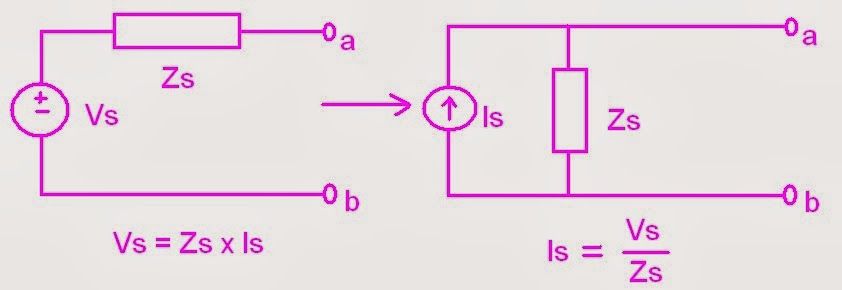In source transformation we have to combine the impedances or
simply the circuit. But remember that we must leave the branch which is the
required parameter is present on it.
Also in source transformation we will transform the voltage
source in series with impedance to a current source in parallel with impedance
or vise-versa. The transformation of the source with impedance will only use
the ohm's Law
Vs = Zs x Is and Is = Vs / Zs.
Illustration:
Example:
Vx is our unknown in the given circuit. We have to simplify this
circuit to obtain Vx.
* means series
3Ω * j4 Ω
Z1 = 3 + j4 Ω
4 Ω * -j13 Ω
Z2 = 4 + -j13 Ω
As we can see from
the circuit, It has a voltage source with series resistor. We will transform it
into a current source with a resistor as what illustration above shows. Using
ohm's Law we have;
I = (20∠-90) /
5 = -j4 A

5 Ω // (3+ j4 Ω)
Z3 = (3+ j4) (5) / (3+ j4) + (5)
Z3 = 2.5 + j1.25 Ω
V = (-j4) x (2.5 + j1.25)
V = 5 - j10 V

(2.5 + j1.25 Ω) * (4 + -j13 Ω)
Z4 = (2.5 + j1.25) + (4 + -j13)
By this time, we will apply voltage division.
Vx = ( Zx ) (Vs) / (Zx) + (Z)
Vx = ( 10 ) (5 - j10) / ( 10 ) (6.5 -
j11.75)
Vx = 5. 519 ∠ -27.98 V
I've
learned that in solving unknown in Ac circuit, we can also use source transformation.
For me this is much easier to use than to the other in simplifying the circuit
because it lessen your time making solutions. It gives you many illustrations
how the circuit changes while solving the problem. Ohm's Law is the most
formula we used in here so it is quiet easy. Source transformation can be use
for checking your circuit if you are confused.





No comments:
Post a Comment